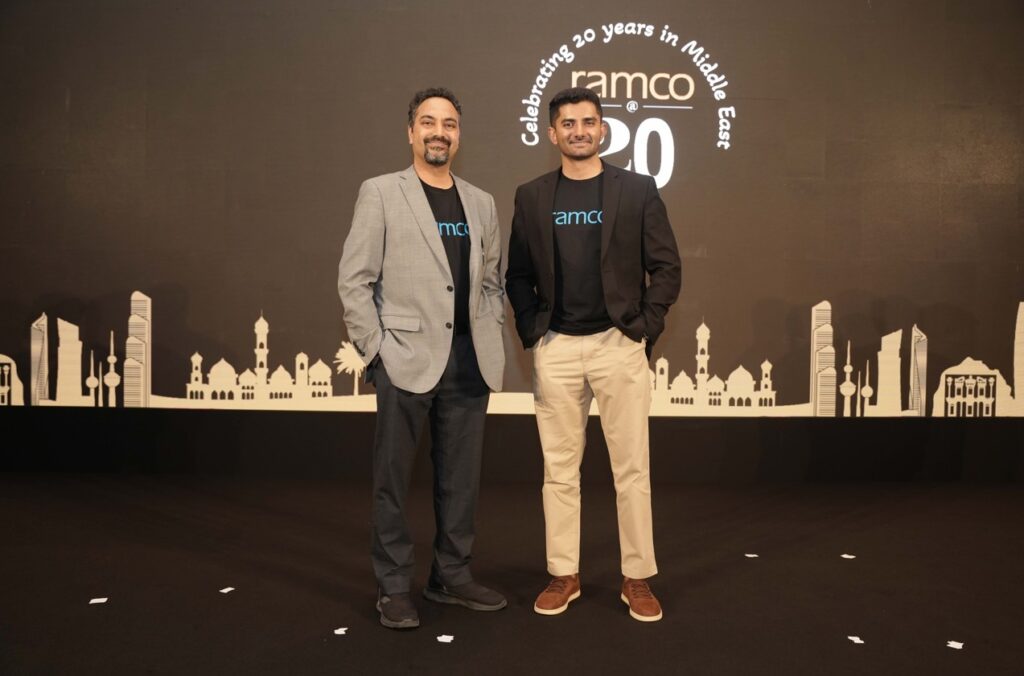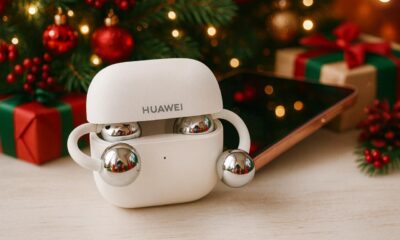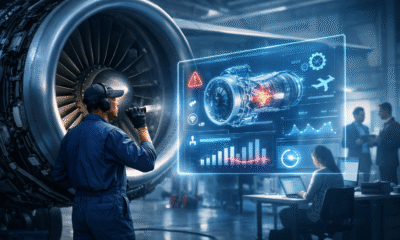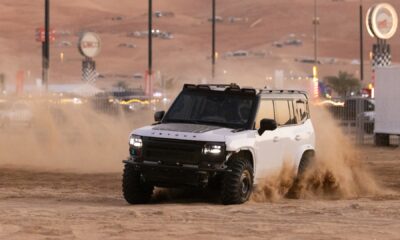Tech Features
Breaking Boundaries and Driving Inclusive Innovation in Tech

Laura Hernandez Gonzalez, Managing Director for MENA at Globant opens up about her mission to foster diversity, inclusivity, and innovation in the tech world. She shares her approach to leading projects that prioritize the integration of emerging technologies like AI, while ensuring that these advancements benefit underserved communities and drive positive societal change.

What inspired your journey into technology and business strategy, and how did you transition into leadership roles in the industry?
From the start, my path into technology and business strategy has been shaped by curiosity, adaptability, and a deep belief in transformation through innovation. With a background in chemical engineering, I started my career in the Oil & Gas sector, where I was exposed very quickly to large-scale transformation projects and the power of digitalization. Working on pioneering technology-driven initiatives sparked my passion for strategic problem-solving and business evolution, eventually leading me to transition into business consulting. There, I found the opportunity to help organizations rethink their models and unlock new avenues for growth through technology and innovation.
Throughout my career, I’ve also embraced an entrepreneurial mindset, taking on initiatives that required me to navigate uncertainty, build solutions from the ground up, and drive meaningful impact beyond traditional corporate structures. This experience reinforced my ability to spot opportunities, adapt quickly, and lead with a results-driven approach—qualities that have shaped my leadership style over the years.
Working across multiple industries, countries, and cultural landscapes, has helped me gain a global perspective that has been instrumental in shaping my strategic thinking. Understanding different market dynamics, leadership styles, and business environments has only strengthened my belief that adaptability and innovation are key to long-term success. The defining moments in my journey have always been those that challenged me to step outside my comfort zone, embrace change, and take bold action.
What ultimately drew me to the tech industry was its boundless potential to reshape entire sectors. Technology is no longer a supporting function—it is the driving force behind transformation in finance, healthcare, entertainment, and beyond. Being part of Globant, a company that partners with the world’s most influential brands, has allowed me to contribute to high-impact projects while continuously evolving as a leader.
Today, leadership in technology is not about authority—it’s about empowerment. At Globant, we embrace a leadership model that fosters autonomy, collaboration, and continuous learning. My role is not to dictate every decision but to create an environment where brilliant minds can thrive, innovate, and challenge the status quo.
Having worked across multiple continents, how have these diverse experiences shaped your leadership style and strategic approach to business?
One of the most powerful lessons I’ve learned is that leadership is rooted in adaptability and empathy. Working across multiple continents—from Europe and the Americas to the Middle East—has reinforced the importance of understanding diverse perspectives, adapting to different business dynamics, and fostering inclusive environments where teams can thrive.
At Globant, with operations in 35 countries across five continents, we have built a culture of collaboration, agility, and innovation. Our Agile Pods model—autonomous, multidisciplinary teams that experiment and innovate continuously—has shown me firsthand that true innovation happens when different perspectives and expertise come together. This approach not only enhances efficiency and creativity but also empowers teams to take ownership of their goals and drive meaningful impact.
My global exposure has shaped my leadership philosophy—I’ve seen that success isn’t just about expertise; it’s about embracing diversity of thought, culture, and experience. Inclusion isn’t just a moral imperative—it’s a competitive advantage, and in a world where technology is bridging gaps and redefining industries, leaders who cultivate diverse, adaptable teams will be the ones who shape the future.
Can you walk us through your daily routine and also share some positive habits you’ve developed to continually improve and adapt in your leadership role at Globant?
Balance is essential. My daily routine revolves around three key pillars: connection, continuous learning, and well-being. No matter how fast-paced our industry is, I prioritize meaningful interactions with my team and clients—because people are at the heart of every successful company. Staying engaged fosters trust, collaboration, and innovation.
The rapid pace of technological change means stagnation is not an option. To stay ahead, I make continuous learning a priority, whether through executive education—like my experience at Stanford GSB—or by engaging with leading voices in the industry. One key takeaway? Technology’s true power is unlocked through human ingenuity and creativity.
Equally important is well-being, because high performance is not sustainable without balance. I ensure that self-care remains a priority, whether through sports, reading, or moments of reflection. Maintaining mental sharpness and energy is essential, not just for personal resilience but for making better, more strategic decisions as a leader.
Great leadership is about inspiring, empowering, and driving meaningful impact. I believe that staying curious, agile, and engaged is what makes this journey fulfilling.
As a woman leader in technology, how do you see AI-driven personalized banking solutions advancing financial inclusion, particularly for women and underserved communities?
AI is reshaping financial services, making them more accessible than ever. Traditional banking models often rely on rigid credit requirements, leaving many individuals—including those in emerging markets—without access to essential financial tools. We are now seeing AI-driven solutions democratizing access to banking, credit, and investment opportunities, reaching populations that were previously underserved.
In regions like the Middle East, where financial ecosystems are evolving rapidly, AI has the potential to expand access to personalized financial services at a larger scale. By leveraging alternative data and intelligent credit scoring, financial institutions can move beyond traditional eligibility criteria and offer more inclusive, tailored financial solutions.
At Globant, we believe in technology for good. AI shouldn’t just drive efficiency; it should empower people. If leveraged correctly, it can help millions gain financial independence and control over their economic futures. The key is to ensure that these technologies are designed with inclusivity, transparency, and ethical considerations at their core.
What’s one important leadership lesson you’ve learned that every woman in leadership roles should embrace?
One of the most important lessons I’ve learned is to embrace challenges, take risks and step out of comfort zones. Growth happens when we push ourselves beyond what feels familiar—whether that means leading a new initiative, transitioning into a different industry, or taking on a bigger role. The key is to say yes to opportunities, even before feeling fully ready—because that’s where real development happens.
Having spent many years in the Middle East, I’ve witnessed firsthand the significant progress in women’s inclusion and leadership across industries. More women are stepping into technology, entrepreneurship, and executive roles, actively shaping the region’s innovation landscape. This transformation highlights the impact of opportunity, mentorship, and education—key drivers of meaningful and lasting change.
Another key lesson is the power of community and mentorship. No one succeeds alone, and building strong networks of support, collaboration, and knowledge-sharing is essential for any leader. At Globant, we encourage a mindset of boldness and continuous learning, providing the tools and support for people to develop professionally and thrive. We actively promote STEM education and initiatives that encourage young women to pursue careers in technology and leadership.
To anyone looking to thrive in tech, my advice is simple:
- Keep learning and evolving—curiosity fuels growth
- Build a network of people who challenge, support, and inspire you
- Own your journey—confidence comes from action, not just certainty
The future of technology is diverse, and we all have a role in shaping it.
Tech Features
From cost efficiency to carbon efficiency: The new metric driving tech decisions

- BY: Ali Muzaffar, Assistant Editor at School of Mathematical and Computer Sciences, Heriot-Watt University Dubai
n boardrooms across the globe, something big is happening, quietly but decisively. Sustainability has evolved far beyond being a “nice-to-have” addition to an ESG report. It’s now front and centre in business strategy, especially in tech. From green computing and circular data centers to AI that optimizes energy use, companies are reshaping their technology roadmaps with sustainability as a core driver and not as an afterthought.

Not long ago, tech strategy was all about speed, uptime, and keeping costs per computation low. That mindset has evolved. Today, leaders are also asking tougher questions: How carbon-intensive is this system? How energy-efficient is it over time? What’s its full lifecycle impact? With climate pressure mounting and energy prices climbing, organisations that tie digital transformation to their institutional sustainability goals.
At its heart, green computing seeks to maximize computing performance while minimising environmental impact. This includes optimising hardware efficiency, reducing waste, and using smarter algorithms that require less energy.
A wave of recent research shows just how impactful this can be. Studies indicate that emerging green computing technologies can reduce energy consumption by 40–60% compared to traditional approaches. That’s not a marginal improvement, that’s transformational. It means smaller operating costs, longer hardware life, and a lower carbon footprint without sacrificing performance.
Part of this comes from smarter software. Techniques like green coding, which optimise algorithms to minimise redundant operations, have been shown to cut energy use by up to 20% in data processing tasks.
Organisations that adopt green computing strategies aren’t just doing good; they’re driving tangible results. Informed by sustainability principles, energy-efficient hardware and
optimisation frameworks can reduce energy bills and maintenance costs at the same time, often with payback periods of three to five years.
Data centres are the backbone of the digital economy. They power software, store vast troves of data, and support the artificial intelligence systems driving innovation. But this backbone comes with a heavy environmental load. Collectively, global data centres consume hundreds of terawatt-hours of electricity each year, which is about 2% of total global electricity.
As AI workloads surge and data storage demand explodes, energy consumption is rising sharply. Looking ahead to 2030, the numbers are hard to ignore. Global data
centre electricity demand is expected to almost double, reaching levels you’d normally associate with an entire industrialised country. That kind of energy appetite isn’t just a technical issue, it’s a strategic wake-up call for the entire industry.
This surge has forced a fundamental rethink of how data centres are built and run. Enter the idea of the circular data centre. It’s not just about better cooling or switching to renewables. Instead, it looks at the full lifecycle of infrastructure, from construction and daily operations to decommissioning, recycling, and reuse, so waste and inefficiency are designed out from the start.
The most forward-thinking operators are already implementing this approach. Advanced cooling methods, such as liquid cooling and AI-driven thermal management, are revolutionising the industry, reducing cooling energy consumption by up to 40% compared to traditional air-based systems. That’s a big win not only for energy bills, but also for long- term sustainability.
Beyond cooling, operators are turning heat waste into a resource. In Scandinavia, data centres are already repurposing excess thermal output to heat residential buildings, a real- world example of how technology can feed back into the community in a circular way. These strategies are already showing results, with approximately 60% of data centre energy now coming from renewable sources, and many operators are targeting 100% clean power by 2030.
Circular thinking extends to hardware too. Companies are designing servers and components for easier recycling, refurbishing retired equipment, and integrating modularity so that parts can be upgraded without replacing entire systems.
For businesses, circular data centres represent more than environmental responsibility. They can significantly lower capital expenditures over time and reduce regulatory risk as governments tighten emissions requirements. While AI itself has been criticised for energy use, the technology also offers some of the most effective tools for reducing overall consumption across tech infrastructure.
AI algorithms excel at predictive optimisation, they can analyse real-time sensor data to adjust cooling systems, balance computing loads, and shut down idle resources. Across case studies, such systems have reliably achieved 15–30% energy savings in energy management tasks in cloud environments, dynamic server allocation and AI-assisted workload management have contributed to energy savings of around 25% when compared with conventional operations.
Tech Features
The Bold AI Rewrite of Enterprise Software!

By Srijith KN, Senior Editor, Technology Integrator
Celebrating more than two decades in the region—and backed by over 800 enterprise customers—Ramco Systems is not merely expanding; it is doubling down on its presence. With a 50-member local team and a roadmap anchored in deep product localization, the company’s strategy is clear: build for the region, in the region. Local language support, government-portal integrations, and strict alignment with regional data privacy laws form the foundation of Ramco’s next chapter.

At the media roundtable held in Dubai as part of Ramco@20, Integrator had a front-row view into the company’s transformation; one that is not just incremental but architectural. From pioneering client-server systems to shaping modern SaaS platforms, Ramco has long played in the innovation lane. But what they are now setting their sights on could reshape the enterprise software landscape once again: AI-native enterprise systems.
From System of Record to System of Intelligence
Ramco’s next strategic leap is a shift from traditional enterprise software—rigid, transactional, and complex—to a fluid “system of intelligence.” Imagine an enterprise app that doesn’t wait for instructions but proactively surfaces insights, flags anomalies, and allows employees to manage operations through natural conversation. That is the future Ramco is building toward.
One of their strongest verticals—HR and payroll—illustrates this ambition. They already support organizations with massive workforce structures, including companies with over 100,000 employees and more than 1,000 pay components. Under an AI-powered interface, many of these complicated workflows will compress into simple prompts, removing friction from one of the most complex business domains.
A ChatGPT-Like Canvas for Enterprise Work
The company demonstrated an early preview of its conversational interface; a clean, unified canvas where users can query pending purchase requests, generate reports, or even create purchase orders using a single natural language prompt. The UX remains consistent for all, but the underlying workflows, context, and AI-generated outputs adapt to individual users and company-specific processes.
But the most compelling use cases emerged when the discussion shifted to aviation; a sector where Ramco already has deep domain expertise.
AI on the Hangar Floor: A Glimpse into Aviation’s Future
Picture a technician standing beside a massive aircraft engine, disassembling components, identifying faults, replacing parts, and logging every detail meticulously. Aviation is unforgiving—every part must meet airworthiness standards, track flying hours, and comply with stringent regulations. Only certified personnel can work on the engine, and even the tools they use must be OEM-mandated.
Now layer AI into that setting.
As a technician opens an engine and reports an issue—say, a damaged blade—the AI instantly scans 15–20 years of historical maintenance data. It recognizes patterns and alerts the technician:
“John, you’re replacing this blade on an A380. Historically, whenever this part is replaced, another related fault tends to appear within eight months. Would you like to inspect that area as well?”
This is not a textbook recommendation. It is institutional memory—decades of real-world faults and fixes—surfacing as real-time intelligence. The system becomes a second expert on the floor, conversing with technicians, guiding actions, and ensuring nothing slips through the cracks. This simple conversational canvas, Ramco argues, has the potential to reshape ground-level operations in one of the world’s most complex industries.
The Critical Question: What About Data Privacy?
As enterprise AI evolves, the most pressing concerns are no longer about innovation; they’re about protection. So, we asked the question that matters most: How does Ramco secure customer data in an AI-driven future?
Their answer was reassuringly clear:
- All AI workloads are hosted locally within the customer’s private environment.
- Data never leaves the region. Workloads are deployed in the customer’s local data center.
- Every customer gets an isolated AI instance. No shared environments, no cross-pollination of data.
- No external web calls, ensuring full containment and compliance.
In an era where enterprises fear the opacity of AI, Ramco is betting on transparency and regional sovereignty.
The Road Ahead
Ramco’s mission is ambitious: to redefine enterprise apps through AI and shift the industry from systems that store data to systems that think. And based on what we witnessed at Ramco@20, this is not a distant vision; it is already taking shape on factory floors, in payroll departments, and inside aircraft hangars.
The next era of enterprise software won’t just automate processes. It will understand them. And Ramco is positioning itself to become one of the first global players to make that leap—from record-keeping to intelligence-building—right here in the region.
About Ramco Systems
Ramco Systems is a world-class enterprise software product/platform provider disrupting the market with its multi-tenant cloud and mobile-based enterprise software, successfully driving innovation for over 25 years. Over the years, Ramco has maintained a consistent track record of serving 800+ customers globally with 2 million+ users and delivering tangible business value in global payroll, aviation aerospace & defense, and ERP. Ramco’s key differentiator is its innovative approach to develop products through its revolutionary enterprise application assembly and delivery platform. On the innovation front, Ramco is leveraging cutting-edge technologies around artificial intelligence, machine learning, RPA, and blockchain, amongst others, to help organizations embrace digital transformation.
Tech Features
HOW GCC OPERATORS CAN LEAD THE NEXT AI WAVE WITH FUTURE-PROOF OPTICAL NETWORKS

By Pete Hall, Regional Managing Director, Ciena Middle East & Africa
Artificial Intelligence (AI) is advancing at a rapid pace in the region, driving innovation across various industries. The GCC now stands at a pivotal moment, with AI transitioning from a hyperscaler-centric phenomenon to a ubiquitous force shaping enterprise and consumer networks alike.
Globally, Amazon Web Services (AWS), Google Cloud, Microsoft Azure and NVIDIA have stepped in to manage large-scale computing and data processing needs. Unlike traditional data centers, they are built to meet evolving workloads without major infrastructure changes.
The rapid expansion of data centres to meet soaring demand is also evident in the UAE, where du announced a deal with Microsoft to set up a data centre in the country to revolutionize the digital ecosystem. Next door, Saudi Arabia has been expanding its investments in data centres to drive its wider ambitions to become a regional AI leader and global tech hub.
While much of the AI optics boom has so far been confined to data center interconnects, growth is now shifting from AI model training to AI inferencing, where AI models can make accurate predictions based on new data. However, it takes data-intensive AI training to make this a reality.
As new AI applications such as AI-powered analytics, immersive media, and automation are expected to surge through 2030, the next wave will demand robust, low-latency, high-capacity optical transport across metro and long-haul networks.
In particular, GCC markets are primed to experience rapid uptake due to national AI agendas and smart city initiatives. A 2025 survey shows AI traffic could account for 30–50% of metro and long-haul capacity within three years. It is interesting to note that enterprises, not hyperscalers, are expected to drive the most network traffic growth over this period.
As the AI traffic boom moves beyond the data centre, low latency, high capacity, and resilient optical links will be the key differentiators for AI-driven workloads. This is precisely where regional telcos can take the lead. The market for capacity is already evolving quite rapidly.
Earlier this year, e& UAE became the first in the Middle East and Africa to deploy Ciena’s WaveLogic 6 Extreme, achieving ultra-high-speed 1.6 Tb/s per wavelength connectivity. This advancement supports 10 Gb home services and wholesale and domestic business customer traffic with 100G and 400G requirement.
The GCC’s investment in high-capacity optical networks, powered by new innovations such as WaveLogic 6, provides a competitive advantage in meeting the increasing AI traffic demands. If they are to take this to the next level, GCC telcos must capitalize on their relatively greenfield networks to deploy future-proof optical infrastructures faster than more mature markets constrained by legacy systems.
GCC operators are charting a new course as AI enablers, leveraging managed optical fiber networks and AI-optimized SLAs to deliver greater value and innovation beyond traditional bandwidth services.
To accelerate this journey and speed time to market, operators are also taking steps to address capex constraints, skill gaps, and organizational alignment. By positioning themselves as AI ecosystem leaders, they can unlock long-term revenue and resilience.
There is a real window of opportunity for GCC operators to capitalise on the AI optical wave. Thanks to national AI strategies, sovereign cloud initiatives, and hyperscaler partnerships, they already have a head start. By continuing to invest in future-proof, high-capacity, low-latency optical networks they can ensure network readiness for AI’s exponential traffic growth. The next three years will determine whether GCC operators shape the AI economy or chase it.
-

 Tech News1 year ago
Tech News1 year agoDenodo Bolsters Executive Team by Hiring Christophe Culine as its Chief Revenue Officer
-

 VAR8 months ago
VAR8 months agoMicrosoft Launches New Surface Copilot+ PCs for Business
-

 Tech Interviews2 years ago
Tech Interviews2 years agoNavigating the Cybersecurity Landscape in Hybrid Work Environments
-

 Tech News5 months ago
Tech News5 months agoNothing Launches flagship Nothing Phone (3) and Headphone (1) in theme with the Iconic Museum of the Future in Dubai
-

 Tech News2 years ago
Tech News2 years agoBrighton College Abu Dhabi and Brighton College Al Ain Donate 954 IT Devices in Support of ‘Donate Your Own Device’ Campaign
-

 VAR1 year ago
VAR1 year agoSamsung Galaxy Z Fold6 vs Google Pixel 9 Pro Fold: Clash Of The Folding Phenoms
-

 Editorial1 year ago
Editorial1 year agoCelebrating UAE National Day: A Legacy of Leadership and Technological Innovation
-

 Cover Story10 months ago
Cover Story10 months agoUnifonic Leading the Future of AI-Driven Customer Engagement

























